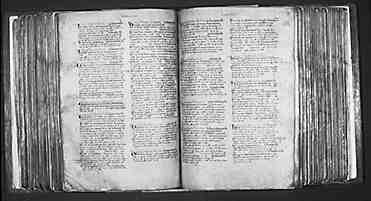 |
| The
Codex |
|
|
| |
 |
This
starts to make sense when we look at how the pages of a book were assembled.
The parchment
sheets, when cut to size, represented two pages of the manuscript book. |
 |
Each
sheet was divided in half. |
 |
The
sheets were folded. |
 |
Several
folded sheets were placed one inside the other to form a sort of pamphlet. |
 |
This
produced a gathering
or quire. A number
of these gatherings was assembled together and bound to form the codex.
However, the preparation and writing was generally carried out on the
loose gathering before it was bound. |
|
A
leaf or a double sided page is usually referred to as a folio,
abbreviated as f. and in the plural as ff. Each folio was numbered, not each
individual page. Conventionally the front or right hand side is known as the
recto, abbreviated as
r., while the left hand side is called verso,
abbreviated as v.. Occasionally other conventions have been used, and in the
example above they use b. rather than v. for the reverse side of the page.
When the book is opened it displays a double page or bifolium.
If, for example f.4v is on the left, then f.5r will be on the right. |
|
|
|
A
famous book, Domesday Book in the London National Archives, open to display
a bifolium. The verso page is on the left, the recto on the right. |
 |
To
prepare the page for the scribe,
the lines for writing on and for containing the columns were drawn up.
This was started by pricking the edges of the page through all the leaves
of the gathering to form a guide for the lines. In the earlier medieval
period these lines were scored on the page, hard
point. Later red lead was used, referred to as plummet.
Later still lines were drawn with coloured ink. |
|
This
segment from a 12th century Life of St Martin of Tours shows the ruled lines
for the text (Metz. Stadtbibliothek, Salis. MS 37, f.4). |
|
| After
the scribe had written on the prepared pages, still in the form of gatherings,
and other embellishments had been added, the gatherings were assembled
for binding. Sometimes the last page of each gathering had some sort of
identification; a number, a signature or in the later medieval period,
a catchword.
A catchword was the first word of the next gathering written in the bottom
corner of the page. This is very handy for the codicologist as it is possible
to tell whether leaves or whole gatherings have been lost as a result
of rebinding over the centuries and is a check on the integrity of the
manuscript. |
 |
This
example shows a folio with a catchword entered at the bottom of the page.
Below is an enlargement of the catchword. At the bottom are the first two
lines of the following page, showing that the first word is the same as the
catchword. Note also the red ruling of the guide lines for writing. |
|
Details
from a book of hours (National Library of Australia, MS 1097/9, ff.30v and
31r), from lauds for the Hours of the Virgin. By permission of the National
Library of Australia. |
 |
 |
|
Finally,
from this first example, incipit
and explicit refer
to the headings that were often placed at the beginning and end of sections
of the text. "Here ends the gospel according to St Matthew. Here begins the gospel according to St Mark" or whatever is appropriate. These were written in large display scripts
or rubric and served
as place markers for the reader. |
|
continued
 |
 previous page
previous page |
 Forms of Manuscripts
Forms of Manuscripts |
|
 |
 |
 |
 |
 |








